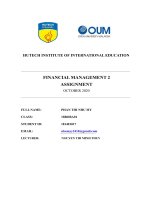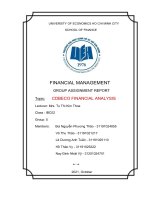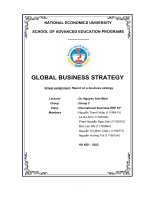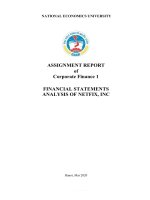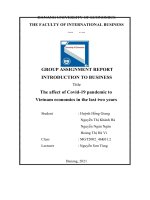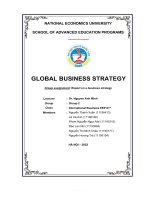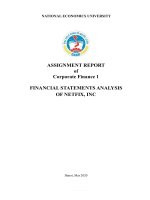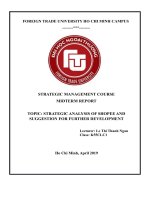financial management group assignment report topic cdbeco financial analysis
Bạn đang xem bản rút gọn của tài liệu. Xem và tải ngay bản đầy đủ của tài liệu tại đây (1019.79 KB, 28 trang )
UNIVERSITY OF ECONOMICS HO CHI MINH CITY
SCHOOL OF FINANCE
FINANCIAL MANAGEMENT
GROUP ASSIGNMENT REPORT
Topic:
CDBECO FINANCIAL ANALYSIS
Lecturer: Mrs. Tu Thi Kim Thoa
Class : IBC02
Group: 5
Members:
Bùi Nguyễn Phương Thảo - 31191024855
Võ Thu Thảo - 31191021217
Lê Dương Anh Tuấn - 31191025110
Hồ Thảo Vy - 31191025222
Nay Đinh Nhật Vỹ - 31201024701
⇜⇝
2021, October
download by :
TABLE OF CONTENTS
PART I: INTRODUCTION
Founding
Expansion
Organizational structure
The overall market
Competitors
PART II: ANALYSIS OF PROFIT/LOSS AND BALANCE SHEET
Balance sheet
Income statement
PART III: RATIO ANALYSIS
Liquidity ratio
Long-term solvency ratios
Efficiency ratio
Profitability ratio
Market value ratio
PART IV: CONCLUSION
IN EACH OF ASPECTS
IN GENERAL
PART V: REFERENCES
1
download by :
PART I: INTRODUCTION
Chuong Duong Beverage Joint Stock Company was formerly the Usine Belgique
factory belonging to B.G.I Group (France). This was the largest beverage factory in
the South before 1975. In mid-1977, BGI Group officially transferred ownership
and handed over the entire factory to the state with the name “Chuong Duong Soft
Drink Factory”. After many years of operation in the beverage industry, Chuong
Duong is currently one of the leading companies in Vietnam.
Name
Short name
Parents company
Postal address
Internet address
Independent audit firm
Tax code
Stock code
1
Công Ty Cổ Phần Nước Giải Khát Chương Dương. Thongtindoanhnghiep.co. (2015). Retrieved 19 September
2021, from />
2
download by :
Listing floor
Ho Chi Minh City Stock Exchange
Industries served
Beverage
Geographic areas served
Vietnam
Current Chairman
Neo Gim Siong Bennett
a) Founding
Chuong Duong has been a familiar soft
drink brand to most people in the Southern part
of Vietnam for more than 60 years with its
unique sarxi flavor. Having been present in
Vietnam since the 1950s, but Chuong Duong
really marked an important turning point only
when officially operating as a joint stock
company on June 2, 2004 with a charter capital
of VND 85 billion. In that total amount, Saigon
Beer - Alcohol - Beverage Corporation
(SABECO) held 51% controlling stake.2
Currently, as of March 16, 2021, SCD's largest shareholder is still Sabeco
with 62% of charter capital, followed by Venture Investment Joint Stock Company
and PYN Elite Fund holds 12.47% and 5.65% of charter capital respectively.
b) Expansion
Currently, the company is operating with a production line for extracting
glass bottles, a line for filling PET bottles and a line for filling cans; with over 500
employees working 2 shifts/day. The average output of the Company has grown
continuously from 2.7 million liters in the period 1977 - 1985 to 22.9 million liters in
1988 - 1992 and reached more than 38 million liters up to the present time.
According to CDBECO's 2020 financial report, the company's net
revenue in the year is about 259 billion VND and profit after tax is 12.8 billion
VND, equivalent to a decrease of 3% and 26% compared to the 2019 results.
Currently, the classification of small and medium-sized enterprises is
based on the average number of employees participating in social insurance
per year and revenue or capital source (with priority given to revenue). From
the above information, it can be seen that CDBECO is a medium-sized
enterprise in the manufacturing sector with more than 500 employees and 85
billion VND investment capital.
2
Câu chuyện thương hiệu - Chương Dương. Retrieved 19
September 2021, from />
3
download by :
c) Organizational structure
The structure of CDBECO's Executive Board
Board of Directors
Majority-owned subsidiaries
No.
1
2
3
4
Name
Branch of CD Beverage Joint
Stock Company in Nha Trang
Sales and Distribution Center
Branch of Chuong Duong
Beverage Joint Stock Company
Go Dau Branch - Chuong Duong
Beverage Joint Stock Company
4
download by :
d) The overall market
The company's business areas include:
● Producing and trading in beverages (mainly).
● Producing and trading in raw materials, packaging, equipment and
technology related to the beverage sector.
The company's main products include:
● Carbonated soft drinks (glass bottles, cans and PET bottles): sarxi,
orange flavor, strawberry flavor, mint, Cream soda, soda.
● Non-carbonated beverage: aloe vera flavor.
● Bottled purified water.
e) Competitors
Beverage is a commodity in the FMCG industry, it has great consumption in
the world with advantages of convenience and deliciousness. In Vietnam, the
beverage market is considered to have strong growth nationally. Currently,
according to estimates of the Vietnam Beer and Alcoholic Beverage Association
(VBA), there are about 1800 beverage production facilities in the country with an
annual growth rate of 6-7%. Among them, prominent brands in the market can be
listed as Coca Cola, Pepsico, Vinamilk, Vinacafé, Trung Nguyen Coffee, Tan Hiep
Phat Group, TRIBECO, Lavie, Vinh Hao, Sanna Khanh Hoa,...
However, in this report, we choose Sanna Khanh Hoa Beverage JSC (SKN) as
a direct competitor based on the following criteria:
● Both Chuong Duong and Sanna Khanh Hoa are Vietnamese companies
operating in the field of beverage production.
● Sanna's most recent three-year financial statements is clear, audited by
FAC and available on the official web.
● Sanna has the same level of awareness and satisfaction as Chuong
Duong in the Vietnamese beverage market.
5
download by :
PART II: ANALYSIS OF PROFIT/LOSS AND BALANCE SHEET a)
Balance sheet
Through data collection and comparison with other companies in the same
FMCG industry that Chuong Duong Beverage is doing business in, our group chose
Sanna Khanh Hoa Beverage to compare with Chuong Duong, as a direct competitor.
According to the financial statements published by Chuong Duong Beverage
and Sanna Khanh Hoa companies for the years 2018, 2019 and 2020, respectively,
we have two balance sheets with the following absolute values. Besides, according to
the balance sheet in the financial statements announced by the company, Sanna
Khanh Hoa does not disclose long-term debts (non-current liabilities). Therefore, it is
not shown in Sanna Khanh Hoa's absolute balance sheet below.
Chuong Duong
Asset
Liabilities and Stockholders'
equity
Sanna Khanh Hoa
Asset
Liabilities and Stockholders'
equity
6
download by :
Total
Because the size of each company is different, in this case we will
compare the ratios through the common-size balance sheet shown below,
which also mentions the changes in each year.
● Chuong Duong Beverage
Common-size balance sheet
Chuong Duong
Asset
Liabilities and Stockholders' equity
Change in each year
Chuong Duong
Change
From 2018 to 2019:
From 2019 to 2020:
Change
From 2018 to 2019:
From 2019 to 2020:
In this form, we can see that although current assets of Chuong Duong
Beverage increased slightly from 2018 to 2019 at about 1.9%, from 81.72 to 83.62%.
7
download by :
However, their current assets were 44.5% of total assets in 2020, down from
83.62% in 2019, strongly decreased 39.12%. Current liabilities declined from
17.11 % to 9.72% of total liabilities and equity over the period of 2019-2020 –
the time of Covid-19. Total equity decreased from 74.49% of total liabilities
and equity to 47.24%.
Overall, Chuong Duong Beverage’s current assets, current liabilities and total
equity all decreased after the Covid-19 shock. Thus, the company’s liquidity, as
measured by current assets compared to current liabilities, decreased over the year.
● Sanna Khanh Hoa
Common-size balance sheet
Sanna Khánh Hòa
Asset
Liabilities and Stockholders' equity
Change in each year
Sanna Khánh Hòa
Change
From 2018 to 2019:
From 2019 to 2020:
Change
From 2018 to 2019:
From 2019 to 2020:
8
download by :
In this form, we can see that Sanna Khanh Hoa's current assets increase
year by year by over 8%. As we can see, from 2018 to 2019, their current
assets rose from 49.75 percent to 58.45%, and despite the impact of the
Covid-19 epidemic in 2020, the company's current assets are still up 8.14
percent in that year, to 66.59% compared to 2019.
In addition, the company's current liabilities also decrease year by year by over 3.5%
per year. In 2020, despite being affected by the epidemic, they still decreased by
3.47%. At the same time, the company's total equity is still increasing year by year,
especially during the epidemic period, this number has increased by about 3.47%.
Therefore, in general, the above figures can be concluded that the
company's cash flow and liquidity are in good condition in the last 3 years.
● Chuong Duong Beverage and Sanna Khanh Hoa comparison:
It can be seen that, in the period of 2018 - 2019, current assets of
Sanna Khanh Hoa increased much faster than Chuong Duong Beverage (at
8.7% compared to a rate of only 1.9%). During the Covid-19 pandemic in
2020, Chuong Duong Beverage's current assets plummeted with 39.12%, from
83.62% of total assets to 44.5%. Meanwhile, the decline rate of Sanna Khanh
Hoa was only 8.7%, much lower than Chuong Duong Beverage.
In addition, in terms of current liabilities, both companies have a decreasing
trend in the years from 2018 to 2020, in the period of 2019 - 2020, Chuong Duong
Beverage has a decrease of more than 2 times compared to Sanna Khanh Hoa
(7.39% compared to that of Sanna Khanh Hoa - about 3.47%). However, in terms of
total equity, Chuong Duong Beverage is decreasing year by year, while Sanna Khanh
Hoa is still growing, especially during the Covid-19 pandemic in 2020.
From that, it can be seen that, in normal state, the growth rate of current assets
of Chuong Duong Beverage is slower than that of Sanna Khanh Hoa, and when the
pandemic occurs, this stat decreases much more than the opponent. Although current
liabilities have decreased over the years, the total equity of Chuong Duong Beverage
has also kept that trend, while this index of Sanna Khanh Hoa - their direct competitor,
has increased over the years, despite the pandemic situation. complex. Therefore, it
can be concluded that Sanna Khanh Hoa has a liquidity advantage over Chuong
Duong Beverage, as measured by current assets compared to current liabilities, and
Sanna Khanh Hoa's balance sheet has grown “stronger” over the years.
9
download by :
b) Income statement
With an annual growth rate of the beverage market forecasted at 6% to 2020,
the beverage industry in Vietnam is one of the fastest growing FMCG sectors.
However, the complicated pandemic situation has prevented the development
of many industries, including the beverage market. Although domestic
companies have tried to cope with this change, there are still many difficulties.
As a case in point, Chuong Duong Beverage’s operating revenue has
decreased 104,694,979,234 VND, about 39.2% compared to the previous
year, 2019. The reasons for this drop in revenue are supposed to be:
-
The Covid-19 wave in 2020 has reduced the demand for consumer shopping.
Covid 19 has disrupted the global supply chain, affecting the flow of goods.
Insufficient supply due to production interruption.
However, this significant reduction has happened even before the Covid-19
spread widely in Vietnam. From 2017 to 2019, the operating revenues gradually
went down. From 327,297,597,399 VND in 2017, it decreased by 49,298,295,803
VND (15.06%) in 2018 and continuously dropped to 267,086,490,066 VND.
These datas explain the company’s performance, which is getting worse over the
years. There has been a decline in units sold over the years, therefore, cost of
goods sold (which are directly tied to the production of the products, including the
cost of labor, materials, and manufacturing overhead) and total expenses also
gradually went down. Specifically,
● Cost of goods sold in 2017 was 327,297,597,399 VND, decreased
15,58% in 2018, 7.3% and 37.87% in 2019 and 2020 respectively. In
2020, the year of difficulties for most industries, the cost of goods sold
10
download by :
of Chuong Duong Beverage was 74,892,892,159 VND,
approximately 77.11% smaller than that in 2017.
● Similarly to the cost of goods sold, total expenses experienced a
downward trend during the 2017-2020 period. During 4 years from 2017
to 2020, total expenses were 90,994,719,162 VND, 78,314,146,099
VND, 66,514,529,427 VND, 53,199,281,264 VND respectively. In other
words, the total expenses lessened around 15% annually.
Besides manufacturing and trading soft drinks, the company also invests
in real estate and producing things related to the beverage sector such as raw
materials, packaging, equipment and technology. These activities give the
company both gains and losses every year.
The year 2018 witnessed a significant increase in the total non-operating gains
2,201,607,931 VND compared to just about 446,371,020 VND in 2017 (a 393,22%
rise). This data showed that the company was making positive changes thanks to the
reduction of expenses such as sales, corporate management and financial expenses.3
In addition, the company also invested in real estate projects such as the land plot in
My Phuoc and Vo Van Kiet. From the year 2018 onwards, the amount of non-operating
gains steadily decreased to the present, 495.67% and 45.11% respectively.
However, the figure for non-operating losses showed an opposite pattern. From
2017 to 2019, it kept increasing from 521,395 VND to 5,524,979 VND and reached a peak
at 502,884,966 VND. This was the result of the construction of a new factory in Dong Nai
Province that commenced at the end of 2019. In the following year, the amount of nonoperating losses was estimated at 236,516,599 VND, a decrease of
3
Quang Thang. (2018, October 20). “Vua” Sá Xị Chương Dương đang trở lại? ZingNews.vn.
Retrieved September 24, 2021, from />
11
download by :
50% compared to 2019 because the company must focus on recovering from
the impact of the pandemic. Overall, it is clear that the non-operating gains
over years is always higher than non-operating losses but the company has
to put more efforts to achieve the best results.
Different from Chuong Duong Beverages, Sanna Khanh Hoa has less
non-operating activities. That is the reason why Sanna Khanh Hoa’s
operating gains are much lower than Chuong Duong.
It is clearly stated that the gap between non-operating gains of Chuong
Duong and Sanna Khanh Hoa is large. In this aspect, while Chuong Duong had
446,371,020 VND in 2017 and always greater than 500 million VND, it even
peaked at 2,201,607,931 VND in 2018; Sanna Khanh Hoa had the highest nonoperating gains was only 200,124,234 VND during that 4 year period.
Sanna Khanh Hoa hadn't put too much effort on investing in non-operating activities.
As a result, the company didn’t bear any losses in this area.
Mentioning how these 2 companies’ cost of sales and Gross profit
proportion, we have: Over the last 3 years, Sanna Khanh Hoa has gained a
positive growth compared to Chuong Duong.
12
download by :
From the year 2018 onwards, it seems like the amount of COGS and
Gross Profit allocated for Chuong Duong experienced a stabilities at around 75%,
while the COGS portion of Sanna Khanh Hoa reduced little by little through 3
years. In detail, the proportion of cost reduced from 73,49% to 69,11% in 2019
and 65,33% in 2020. With this decline in cost of sales, Sanna Khanh Hoa
company seems to have efficiently produced the revenue, therefore they are
likely to have more spending money for business operations.
PART III: RATIO ANALYSIS
a) Liquidity ratio
The tables below compare 3 different liquidity ratios of CDBECO and
Sanna Khanh Hoa.
Table a
CDBECO
Year
2020
2019
2018
2017
Table a’
SKN
Year
2020
2019
2018
● CDBECO:
The current ratios for CDBECO from 2017 to 2020 are generally high, showing
a large investment in the company’s net working capital. These figures also
experienced a rapid increase from 3.59 in 2017 to 4.89 in 2019 before a slight dip of
6.33%, down to 4.58, in 2020. The 2020 current ratio is 4.58, meaning that it has
13
download by :
4.58 VND in current assets for every 1 VND in current liabilities. This is affected by
various types of transactions within the year, one of which may be due to the large
sudden rise in long-term debt of CDBECO: from a total of 720 million VND in 2017
and 2018, to 8,400 million in 2019 (more than 10 times), and 176 billion in 2020
(more 200 times), while total current liabilities just change slightly (see …).
CDBECO is a company in the FMCG industry so the quality of inventory is
strictly considered. In case the beverage products of CDBECO become damaged,
obsolete, or lost, the quick ratio is more preferable to evaluate liquidity of a company.
Quick ratios of CDBECO in 2018 and 2019 experience a quite similar trend
with current ratios: rapid rises, but there was much deeper low in percentage
change in 2020 (at 3.66, dropped by nearly one-fifth of the previous year). This
is perhaps another cause for the high current ratio as already stated.
The final index in this category is cash ratio. It can be seen that in 2018, the
index rose by over half of the previous year to 1.2. Then it decreased by about 16.5%
before going back to 1.08 in 2020. This was true when the cash of CDBECO was just
less than 53 billion in 2018, but it was around 42.5- 43 billion VND in 2017,2019 and
2020. The event showed that there was a great amount of retained earnings from
2017’s operation, but much less in the next consecutive years.
● Sanna Khanh Hoa
Table a’ shows different liquidity ratios for Sanna Khanh Hoa from 2018 to
2020. Overall, figures for Sanna Khanh Hoa are lower than CDBECO in every
corresponding ratio, implying that it’s less capable of dealing with short-term
liabilities.
However, the figures also show a more stable trend of growth for Sanna Khanh
Hoa. For the current ratio of Sanna Khanh Hoa, the number steadily rose by around 40%
each year from 2.13 in 2018 to 4.16 in 2020. Figures for the quick ratio moved in the
same pattern, with an increase of 37% each year. The cash ratio also increased
throughout the years, but it was much less significant in 2020 than in 2019.
b) Long-term solvency
ratios Table b
Table b’
14
download by :
● CDBECO
Looking at the capital structure of Chuong Duong can help give a better understanding
of its financial status. The total debt ratio for the company in each year from 2017 to
2020 was 0.29, 0.25, 0.26, and 1.12 respectively. It is obvious that there was little
change during the first 3 years, but a more than fourfold increase in the last year of the
period. As mentioned, this is attributed to the dramatic rise in long-term debt of the
firm, and it can be perceived that CDBECO was trying to restructure its capital.
● Sanna Khanh Hoa
The capital structure of Sanna Khanh Hoa was similar to that of CDBECO to some
extent, except that it had no long-term debt, and that there was a downward trend
in debt-equity ratio during the 3 year period (shown in table b’).
c) Efficiency ratio
Table c
CDBECO
Year
2020
2019
11,91
2018
10,69
2017
10,08
Table c’
SKN
Efficiency, or Turnover, Ratios
15
download by :
Year
2020
2019
2018
● CDBECO
Table c shows the main efficiency ratios for CDBECO during the 4-year period.
Data in the first column express that Inventory Turnover was normally around 10 12 in 2017, 2018 and 2019. However, it was only 3.36 in 2020, a nearly 72%
plunge. If taking 365 (days) divided by figure for each year, Days’ sales in Inventory
(DSI) can be obtained as seen in the third column of the table. The company took
more than 108 days on average to collect sales back from the current inventory in
2020, more than triple that of the previous 3 years’ DSI. Total Assets Turnover
Index was relatively low in 2020 as well, at 0.4 following a continuous drop from
1.36 in 2017. With this rate in 2020, it would take CDBECO 2.5 years for 1 VND in
assets to create 1 VND in sales. All of these reveal that CDBECO was witnessing a
severe problem in sales performance or inventory management during 2020.
{{Note: They should have better-selling models}}
● Sanna Khanh Hoa
Looking at figures in table c’, and comparing, in 2019 and especially 2020, it
was harder and harder for the company to sell off its inventory. DSI, from
about 18 in 2018, rose to more than 27 in 2019 and then significantly jumped
by 92% to 53 in 2020. Total Assets Turnover for Sanna Khanh Hoa went down
from 2,33 in 2018 to 1,39 in 2020. The overall rate was higher than that of
CDBECO so it can be said that with this scale of company, Sanna Khanh Hoa
had some advantage in managing its assets during the period.
d) Profitability ratio
Table d
CDBECO
Profitability ratios
16
download by :
Year
PM
2020
2019
2018
2017
Table d’
SKN
Year
2020
2019
2018
● CDBECO
Profit Margin (PM), Return on Equity (ROE), and Return on Assets
(ROA) of CDBECO and its competitor will be examined in this part. Thanks to
the Dupont Identity, it is known that these indexes are closely related. An
increase in PM leads to the increase of ROE, for example.
In 2017, CDBECO’s PM was -0.93%, meaning that , from an accounting
perspective, the company lost 0.93 VND for every 100 VND in sales. However, it
witnessed an over 300% and 229% positive rise in PM consecutively during 2018 and
2019. In the year 2020, the figure dropped by two-thirds to 2,11%. ROE and ROA
followed a similar pattern (as seen in table). ROE is a more preferred measure of
performance to shareholders as benefiting shareholders is the main goal of business.
17
download by :
In CDBECO’s case ROE was always slightly higher than ROA due to the
company’s use of financial leverage.
● Sanna Khanh Hoa
Indexes for Sanna Khanh Hoa were more positive than CDBECO during
2018, but became much lower over the next two years.
At the end of 2019, CDBECO witnessed a big rise in PM, ROE, and
ROA with all rising by more than 2 times that of the previous year; while Sanna
Khanh Hoa saw a sharp decline by around 70% for the 3 indexes. After that it
continued to drop in 2020, but this time with a slightly lower rate of change.
Both companies experienced significant loss in profit and efficiency in
2020. However, CDBECO witnessed a much more severe fluctuation than
Sanna Khanh Hoa.
e) Market value ratio
A company’s EPS is one of the most important tools used to evaluate the
business and make investment decisions because it indicates the profitability of a
company. It seems not meaningful when comparing EPS across companies because
the number of shares outstanding for each company is different. However, EPS figures
can be used to compare one company’s performance over time.
According to the financial reports, EPS of both Chuong Duong and
Sanna Khanh Hoa tend to increase, but due to the negative impact of Covid19, they declined in 2020. We can see the EPS of CD is overall much higher
than that of SKN, except for in 2020 when they seem to converge. Specifically,
● Chuong Duong: There was a 2.5 times increase in EPS in 2019 to 1,761
VND, and in 2020, it decreased by 77,06%, back to 404 VND/share.
● Sanna Khanh Hoa: In 2019, EPS increased slightly by 8,73% from 584
in 2018 to 635 VND/share. However, that number dropped 37,32% to
398 VND/share in 2020.
PART IV: CONCLUSION
IN EACH OF ASPECTS
1. Liquidity
Accounting liquidity measures the ease with which a company can meet their
financial obligations with the liquid assets available to them—the ability to pay off
debts as they come due. In CDBECO’s situation, it has a too high current ratio, current
assets are much higher than the current liabilities, which means CDBECO is unable to
18
download by :
